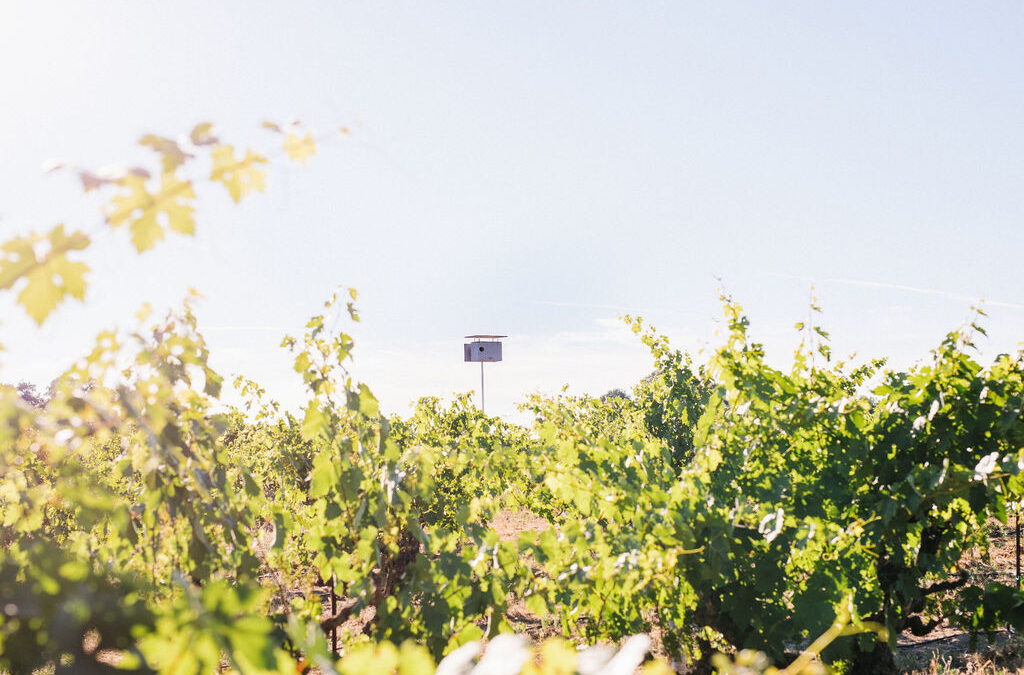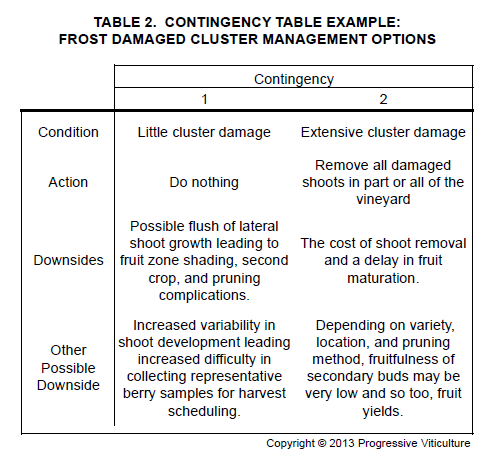MONDAY, NOVEMBER 16, 2020. BY STAN GRANT, VITICULTURIST.
Although we always hope for the best, the future of any vineyard business is uncertain. Possibly, some future events and outcomes could be detrimental to a vineyard’s profitability or create income inconsistency over time (such as frost and powdery mildew epidemics, as in Figure 1). Other occurrences – leafroll virus and trunk disease, for example (Figure 2) – may have a much greater impact that threatens the very economic survival of a vineyard endeavor. Conceivable harmful events and outcomes are termed risks. These are obstacles to success.
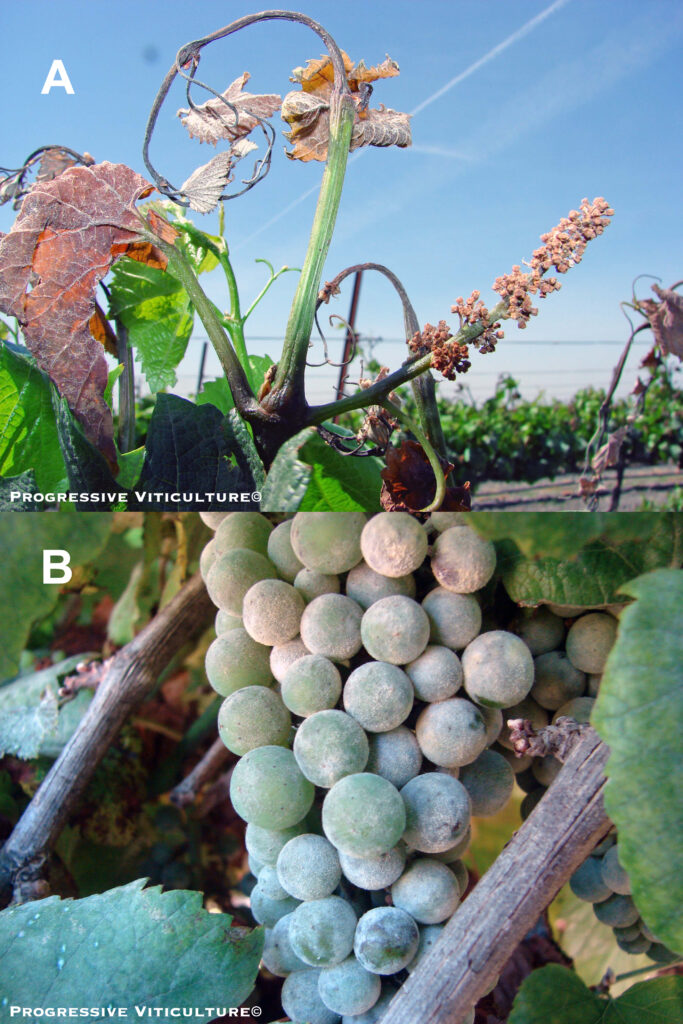
Figure 1. Frost damaged shoot (A) and powdery mildew infected fruit (B) – two short-term risks affecting fruit yields and vineyard revenues during a single growing season. Photo: Progressive Viticulture©.
There is a tendency to think risks are due to inaction, like failing to irrigate when the vines are under severe water stress. However, actions taken at the wrong time, such as when vines are not in a state to fully benefit from them, or actions applied with an improper intensity, can also be detrimental for a vineyard.
Another example of a risk due to action taken at the wrong time is nitrogen fertilizer applied while the vines are dormant, and an example of a risk due to action applied with improper intensity is hedging applied so severely that fruit maturation is impaired. In some instances, improperly applied resources create harmful side effects, some of which can extend beyond the vineyard. Therefore, to ensure a successful vineyard, consideration of risks ought to be part of virtually all management decisions.
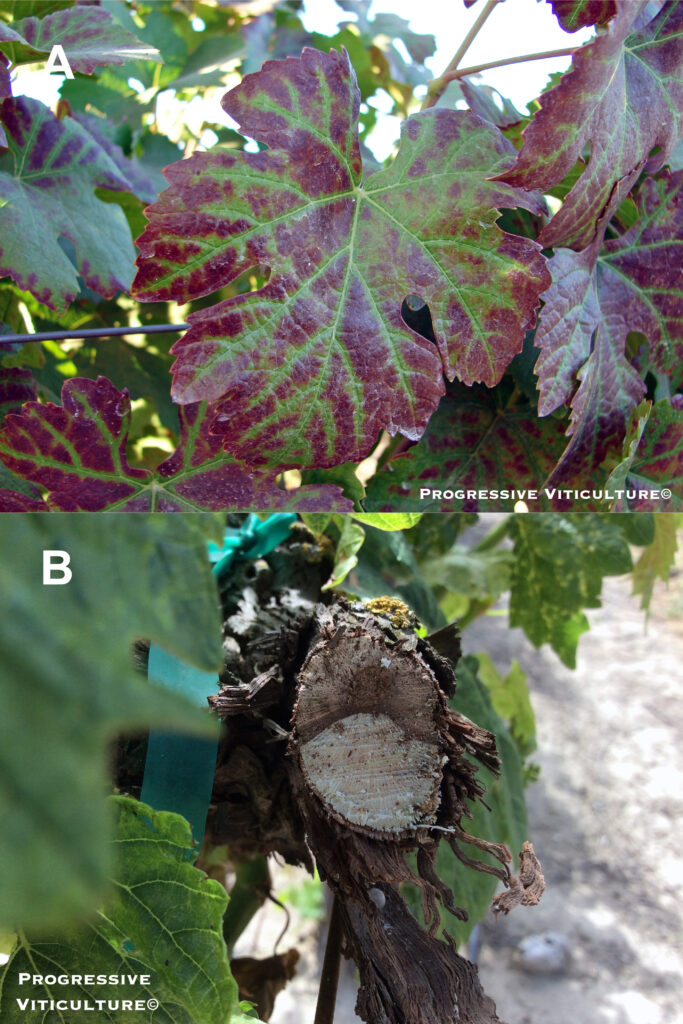
Figure 2. Leaf symptoms of leafroll virus (A) and canker symptoms of cordon and trunk diseases (B) – two long-term risks affecting fruit yields and vineyard revenues to varying degrees over many growing seasons. Photo: Progressive Viticulture©.
Types of Vineyard Business Risks
There are four major classes of vineyard business risks (Table 1). Market risks include decreased demand for winegrapes, lower grape prices, and increased competition from foreign or other domestic producers. Financial risks, such as restricted access to capital, fluctuating interest rates, and slow or non-payment from customers, are also concerns. There are the ever-growing government risks, which all too often take the form of ill-conceived, intrusive, disruptive, and costly policies and regulations.
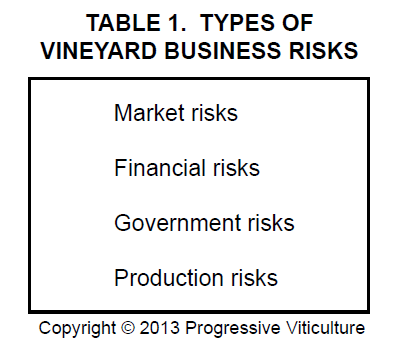
Production risks, the fourth class of vineyard business risks, are multifaceted. They include resource risks, such as reduced availability of labor, equipment, energy, material inputs, technology, and information. Of course, the success of a vineyard business ultimately depends on management skill, and uncertainty about it is a managerial risk. These risks are common to most businesses, but agricultural endeavors have additional risks because they depend upon biological processes and environmental conditions.
Weather risks are famous among these. Frost, high winds, rains, hail, drought, fire, and heat during critical times of the growing season can do significant harm to a crop and the financial well-being of a farming operation. Pests and diseases, including the arrival of new exotic pests, are ever-present risks. For winegrape operations, there are viticultural risks, which encompass short-term as well as long-term trends in fruit production, grape quality, and vineyard profitability connected with vine stresses, vine decline, and diminishing root zone function. Our incomplete knowledge of grapevines and vineyard agroecosystems sometimes compound the viticultural risks accompanying vineyard management decisions.
Managing Vineyard Business Risks
At first glance, vineyard business risks may appear overwhelming, but the existence of many successful vineyard enterprises is a testament to their manageability. An important step in managing vineyard business risks is devising a risk management plan.
Begin composing your plan with headings of the major risk categories: financial risk, market risk, government risk, and production risk. Below each of these headings, list specific types of risks. Then, next to each specific risk, state possible events, their estimated economic consequences, and management strategies for controlling them. For complicated and large magnitude risks, arrange events, consequences, and management strategies into a contingency table to evaluate the trade-offs in risks and returns for various options (Table 2).
Preemptive market risk management strategies may include sales and marketing efforts, the pursuit of strong winery relationships, building a varied customer base, participation in regional promotional efforts, a diversified selection of varieties, and other measures to differentiate your vineyard operation in the winegrape market, such as LODI RULES for Sustainable Winegrowing certification. Well conceived contracts with a diverse set of reliable grape customers, a certain amount of owner equity in business assets, controlled debt, cash and credit reserves, and a close relationship with a lender are potential elements of financial risk management. For government risks, support of industry advocacy groups and engaging and supporting sympathetic elected officials are among management options.
Production risk management begins with staffing efforts focused on competence and effectiveness. Strategies for controlling pests and diseases, optimizing vineyard root zones, and regulating grapevine growth, canopy characteristics, and crop levels and quality follow. Building durable relationships with dependable suppliers of materials, equipment, labor, and custom machinery operations are also essential to minimizing production risks. Seeking sound technical information, promoting winegrape production research, and pursuing further education lessen technical risks.
Varieties, rootstocks, and vineyard designs (spacing-training-trellising-pruning systems) appropriate for your vineyard site in combination with careful vineyard establishment go a long way towards mitigating both short-term and long-term production risks. This presumes newly planted vines are recently tested for known serious virus pathogens (i.e. they are CDFA certified).
When it comes to weather, we can alleviate drought with irrigation and we can provide a certain amount of cold and heat protection. Beyond these, the weather is out of our control. We can, however, lessen financial risks associated with weather damage by having crop insurance.
Of course, devising a risk management plan is only the beginning. It must be implemented. In addition, it ought to be modified as needed to accommodate changing conditions, which requires you to remain observant, flexible, and aware of management options.
Ultimately, risk management is a personal matter based on one’s values, depth of knowledge, past experiences, net worth, financial obligations, commitments to others involved in the operation, and the magnitude of potential gains or losses associated with any particular risk.
A version of this article was originally published in the Mid Valley Agricultural Services January 2013 newsletter and was updated for this blog post.
Further Reading
Bolton, S. What Every Winegrower Should Know: Viruses. Lodi Winegrape Commission. Lodi, California. 2020.
Davidson, D. The Business of Vineyards. Davidson Viticultural Consulting Services. Glen Osmond, South Australia. 2001.
Grant, S. On the nature of vineyards and vineyard management. Lodi Winegrape Commission Coffee Shop Blog. lodigrowers.com/on-the-nature-of-vineyards-and-vineyard-management/. March 06, 2016.
Grant, S. The basic elements of successful vineyard management. Lodi Winegrape Commission Coffee Shop Blog. lodigrowers.com/the-basic-elements-of-successful-vineyard-management/. January 26, 2018.
Grant, S. Quantity, intensity, and timing in the management of vineyard resources. Lodi Winegrape Commission Coffee Shop Blog. lodigrowers.com/quantity-intensity-and-timing-in-the-management-of-vineyard-resources/. February 11, 2019.
Grant, S. Frost management strategies for vineyards. Lodi Winegrape Commission Coffee Shop Blog. lodigrowers.com/frost-management-strategies-for-vineyards/. April 03, 2017.
Grant, S. Comprehensive vineyard water management. Lodi Winegrape Commission Coffee Shop Blog. lodigrowers.com/comprehensive-vineyard-water-management/. August 18, 2015.
Grant, S. Integrated cordon and trunk disease management. Lodi Winegrape Commission Coffee Shop Blog. lodigrowers.com/integrated-cordon-and-trunk-disease-management/. February 10, 2020.
Kay, RD, and Edwards, WM. Farm Management. McGraw-Hill, New York. 1994.
Ohmart, CP, Storm, CP, and Matthiasson, SK (Eds.). Lodi Winegrower’s Workbook, 2nd Ed. pp 187-267. Lodi Winegrape Commission. 2008.
Have something interesting to say? Consider writing a guest blog article!
To subscribe to the Coffee Shop Blog, send an email to stephanie@lodiwine.com with the subject “blog subscribe.”
To join the Lodi Growers email list, send an email to stephanie@lodiwine.com with the subject “grower email subscribe.”
To receive Lodi Grower news and event promotions by mail, send your contact information to stephanie@lodiwine.com or call 209.367.4727.
For more information on the wines of Lodi, visit the Lodi Winegrape Commission’s consumer website, lodiwine.com.

